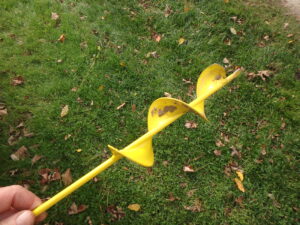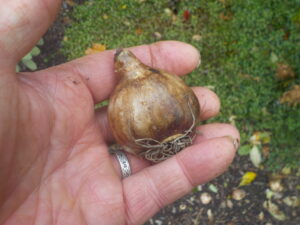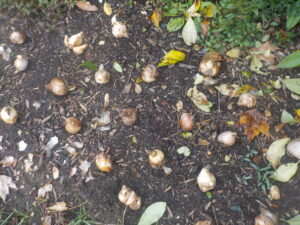Planting Spring Bulbs
Posted on Wednesday, October 19, 2022 · Leave a Comment
As a boy I was surrounded by hundreds of spring daffodils every year. We lived in rural Connecticut, and the people we bought our house from had planted daffodils by the hundreds in our woods. The woods consisted of sugar maples, huge ones, with a sprinkling of ash trees, providing dappled sunshine We had wide raked paths and all along the paths were daffodils in April and May. We would pick 50 or more at a time and bring them into the house and put them in vases everywhere.
So when I bought my house here in Cornish Flat in 1970, I started planting bulbs, too. Except for my years in Africa with the Peace Corps, I have probably planted some every year for over 50 years. It is now getting tough to find places to plant more, but somehow I manage. One trick I use is to put those little white plant tags pushed almost all the way into the ground (so I see less of them) each time I plant a new batch. That way I don’t inadvertently dig up some while trying to find a blank palette.
The first step is to buy bulbs. My local feed-and-grain store has them, as do garden centers and most grocery stores. You can order bulbs on-line if you want things beyond the common ones. But I like to try first to buy locally.
Next, find an appropriate place to plant them. If you are planting small, early-spring bulbs like snowdrops or glory of the snow, you can plant them in the lawn. Just poke holes in the sod for them. Their foliage dies back early. But if you plant daffodils or tulips in the lawn, you won’t be able to mow the lawn until their foliage has replenished the energy in the bulbs, which for daffodils is July 4th – or thereabouts.

Augers are sold to plant bulbs but most cordless drills are not powerful enough to work well scaled
I like to plant a big splash of color in one place. Rather than dig small holes with a trowel or auger, I like to plant a minimum of 25 daffodils or tulips in a wide single hole. To do this, I lay out the bulbs on the ground where I want them, spacing them three inches or so apart. I like a planting of bulbs to be an oval or tear drop shape as opposed to a rectangle. That seems more natural, but do whatever pleases you.
Then I take a hand tool and draw a line around the space designated for the bulbs. I remove the bulbs, and dig out the soil. I don’t dump it on the lawn – I put it in a wheelbarrow or on a tarp so I don’t make a mess on the lawn. I discard any stones as I dig.

Plant with the pointy end up
For depth, follow the directions on the package. Big bulbs like daffodils and tulips generally should be planted at least six inches deep. Little things like crocus only need to be three inches deep. If I dig down six inches, I then add some bulb booster or organic fertilizer in the hole and then loosen the soil for another two inches with my CobraHead weeder (or a three-pronged scratcher). If the soil is heavy clay or very sandy, I add a couple of inches of compost and stir that in.
Next I place the bulbs in the hole in a somewhat random pattern, not straight lines. I wiggle the bulbs around so that the base of each bulb is near the bottom of the loosened and enriched soil. Finally, I shovel the soil from the wheelbarrow back into the soil, being careful not to dislodge my bulbs. If the soil is really crummy, I throw some away and mix in compost to replace it. Bulbs need good drainage.

Lay out bulbs on the soil to determine the size of the hole you need to plant
What about hungry animals that want to eat your flowers before you can enjoy them? Squirrels and chipmunks love tulip bulbs, and have been known to watch from a distance as gardeners plant them – and dig them up almost right away. Some sources claim that adding sharp crushed oyster shells on top of the soil, or near the top, will deter them. I doubt that. Oyster shells won’t deter a tulip-hungry gray squirrel.
Wire mesh buried in the soil above the bulbs will deter squirrels, however. The problem is that when you cut it to size, the edges are razor sharp. When I interviewed the White House gardener at the end of the Clinton years, he reported that they kept squirrels away from their bulbs by feeding them all the corn they could eat. A well fed squirrel won’t bother to dig for tulips, he said. That’s not a good plan, in my view, it will attract more squirrels. I say, if you want tulips, plant them and hope for the best. Having a dog helps, too.
Deer are another problem. Deer love tulip buds and flowers, and will often eat them just before they open. Although there are deer repellent sprays, I think the best solution there is to temporarily surround beds of tulips with wire fencing. Chicken wire comes in three-foot wide rolls that can easily be supported with thin stakes and will keep deer away from your tulips.
Lastly, if you want tulips on your table, you might consider buying them. Local greenhouses near me grow them by the thousand and sell them through my local food coop at a fair price in season. Then you can focus your bulb efforts on things that deer and squirrels won’t eat.
The best bulb in deer country is the daffodil. They are mildly poisonous, so squirrels won’t eat the bulbs and deer won’t eat the flowers. There are over a dozen different named categories of daffodils, and a wide range of colors beyond yellow: white, orange, and even some with a green eye, or center. They will bloom early, mid-season or late in the spring. So buy plenty and enjoy a pest-free spring.





